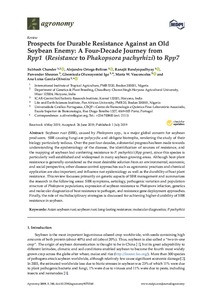| dc.contributor.author | Chander, S. |
| dc.contributor.author | Ortega-Beltran, A. |
| dc.contributor.author | Bandyopadhyay, R. |
| dc.contributor.author | Sheoran, P. |
| dc.contributor.author | Ige, G.O. |
| dc.contributor.author | Vasconcelos, M.W. |
| dc.contributor.author | García Oliveira, A.L. |
| dc.date.accessioned | 2019-12-04T11:36:16Z |
| dc.date.available | 2019-12-04T11:36:16Z |
| dc.date.issued | 2019-07 |
| dc.identifier.citation | Chander, S., Ortega-Beltran, A., Bandyopadhyay, R., Sheoran, P., Ige, G.O., Vasconcelos, M.W. & Garcia-Oliveira, A.L. (2019). Prospects for durable resistance against an old soybean enemy: a four-decade journey from Rpp1 (Resistance to Phakopsora pachyrhizi) to Rpp7. Agronomy, 9(7), 1-23. |
| dc.identifier.issn | 2073-4395 |
| dc.identifier.uri | https://hdl.handle.net/20.500.12478/6180 |
| dc.description | Open Access Journal; Published online: 1 July 2019 |
| dc.description.abstract | Soybean rust (SBR), caused by Phakopsora spp., is a major global concern for soybean producers. SBR causing fungi are polycyclic and obligate biotrophs, rendering the study of their biology particularly tedious. Over the past four decades, substantial progress has been made towards understanding the epidemiology of the disease, the identification of sources of resistance, and the mapping of soybean loci conferring resistance to P. pachyrhizi (Rpp genes), since this species is particularly well established and widespread in many soybean growing areas. Although host-plant resistance is generally considered as the most desirable solution from an environmental, economic, and social perspective, other disease control approaches such as agronomic practices and chemical application are also important, and influence rust epidemiology as well as the durability of host plant resistance. This review focusses primarily on genetic aspects of SBR management and summarizes the research in the following areas: SBR symptoms, aetiology, pathogenic variation and population structure of Phakopsora populations, expression of soybean resistance to Phakopsora infection, genetics and molecular diagnostics of host resistance to pathogen, and resistance gene deployment approaches. Finally, the role of multidisciplinary strategies is discussed for achieving higher durability of SBR resistance in soybean. |
| dc.description.sponsorship | African Union |
| dc.format.extent | 1-23 |
| dc.language.iso | en |
| dc.rights | CC-BY-4.0 |
| dc.subject | Soybeans |
| dc.subject | Disease Resistance |
| dc.subject | Rusts |
| dc.subject | Epidemiology |
| dc.subject | Phakopsora |
| dc.title | Prospects for durable resistance against an old soybean enemy: a four-decade journey from Rpp1 (Resistance to Phakopsora pachyrhizi) to Rpp7 |
| dc.type | Journal Article |
| dc.description.version | Peer Review |
| cg.contributor.crp | Agriculture for Nutrition and Health |
| cg.contributor.affiliation | International Institute of Tropical Agriculture |
| cg.contributor.affiliation | Chaudhary Charan Singh Haryana Agricultural University |
| cg.contributor.affiliation | Indian Council of Agricultural Research |
| cg.contributor.affiliation | Pan African University |
| cg.contributor.affiliation | Universidade Católica Portuguesa |
| cg.creator.identifier | Alejandro Ortega-Beltran: 0000-0003-3747-8094 |
| cg.creator.identifier | Ranajit Bandyopadhyay: 0000-0003-2422-4298 |
| cg.creator.identifier | Garcia-Oliveira AL: 0000-0001-8561-4172 |
| cg.researchtheme | PLANT PRODUCTION & HEALTH |
| cg.isijournal | ISI Journal |
| cg.authorship.types | CGIAR and developing country institute |
| cg.iitasubject | Grain Legumes |
| cg.iitasubject | Plant Diseases |
| cg.iitasubject | Soybean |
| cg.journal | Agronomy |
| cg.howpublished | Formally Published |
| cg.accessibilitystatus | Open Access |
| local.dspaceid | 106565 |
| cg.targetaudience | Scientists |
| cg.identifier.doi | https://dx.doi.org/10.3390/agronomy9070348 |

